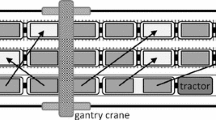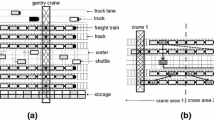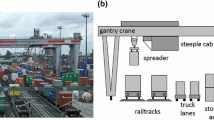Abstract
Multi-trailer trucks (also referred to as road trains) consist of a strong tractor truck pulling about a handful of trailers. They are, for instance, used in large ports to collectively transport a batch of containers between different container yards. We address the decision task where to park successive road trains next to some freight trains, so that a gantry crane can quickly transship the boxes between both means of transport. We formalize the resulting optimization problem and derive suited solution procedures. These algorithms are, then, applied to investigate different managerial aspects such as the relation to preceding decision problems, i.e., the composition of road trains, and the road trains’ efficiency compared to conventional (single-trailer) trucks.







Similar content being viewed by others
References
Barber D, Grobar L (2001) Implementing a statewide goods movement strategy and performance measurement of goods movement in California: METRANS Transportation Center. Accessed May 2017
Boysen N, Fliedner M (2010) Determining crane areas in intermodal transshipment yards: The yard partition problem. Eur J Oper Res 204:336–342
Boysen N, Fliedner M, Jaehn F, Pesch E (2013) A survey on container processing in railway yards. Transp Sci 47:312–329
Boysen N, Scholl J, Stephan K (2017) When road trains supply freight trains: scheduling the container loading process by gantry crane between multi-trailer trucks and freight trains. OR Spectr 39:137–164
Chisman JA (1975) The clustered traveling salesman problem. Comput Oper Res 2:115–119
Cordeau J-F, Legato P, Mazza RM, Trunfio R (2015) Simulation-based optimization for housekeeping in a container transshipment terminal. Comput Oper Res 53:81–95
Duinkerken MB, Dekker R, Kurstjens ST, Ottjes JA, Dellaert NP (2006) Comparing transportation systems for inter-terminal transport at the Maasvlakte container terminals. OR Spectr 28:469–493
European Union Road Federation (ERF) (2009) European road statistics 2008. In: 16th international road federation world road meeting 2009, Lisbon, Portugal
Gilmore PC, Gomory RE (1964) Sequencing a one state-variable machine: a solvable case of the traveling salesman problem. Oper Res 12:655–679
Hafen Hamburg Marketing e.V. (HHM) (2015) Containerumschlag im Vergleich. Top 20 Ports. Port of Hamburg. Accessed Aug 2016 (in German)
Handelskammer Hamburg (HK) (2013) Hafen Hamburg auf einen Blick. Handelskammer Hamburg. Accessed June 2016 (in German)
Heilig L, Voß S (2017) Inter-terminal transportation: an annotated bibliography and research agenda. Flex Serv Manuf J 29:35–63
Kellner M, Boysen N (2015) RMG vs. DRMG: an evaluation of different crane configurations in intermodal transshipment yards. EURO J Transp Logist 4:355–377
Miller CE, Tucker AW, Zemlin RA (1960) Integer programming formulation of traveling salesman problems. J ACM 7:326–329
Nishimura E, Imai A, Papadimitriou S (2005) Yard trailer routing at a maritime container terminal. Transp Res E Logist Transp Rev 41:53–76
Potvin JY, Guertin F (1998) A genetic algorithm for the clustered traveling salesman problem with a prespecified order on the clusters. Advances in computational and stochastic optimization, logic programming, and heuristic search. Springer, New York, pp 287–299
Rotter H (2004) New operating concepts for intermodal transport: the mega hub in Hanover/Lehrte in Germany. Transp Plan Technol 27:347–365
Steenken D, Voß S, Stahlbock R (2004) Container terminal operation and operations research—a classification and literature review. OR Spectr 26:3–49
Tierney K, Voß S, Stahlbock R (2013) A mathematical model of inter-terminal transportation. Eur J Oper Res 235:448–460
Author information
Authors and Affiliations
Corresponding author
Rights and permissions
About this article
Cite this article
Tschöke, M., Boysen, N. Container supply with multi-trailer trucks: parking strategies to speed up the gantry crane-based loading of freight trains in rail yards. OR Spectrum 40, 319–339 (2018). https://doi.org/10.1007/s00291-017-0491-1
Received:
Accepted:
Published:
Issue Date:
DOI: https://doi.org/10.1007/s00291-017-0491-1




